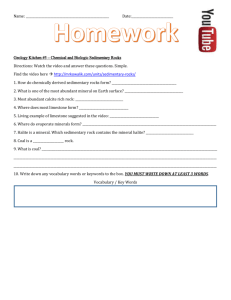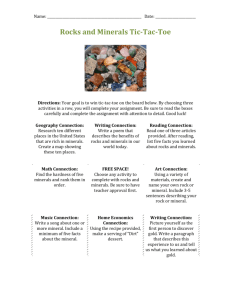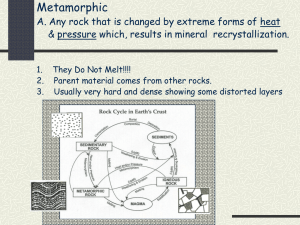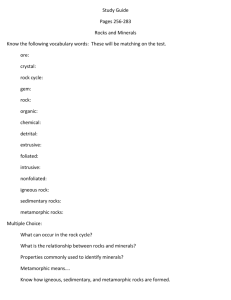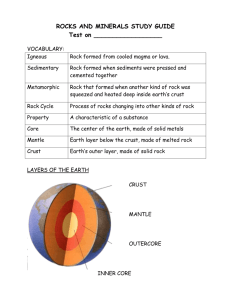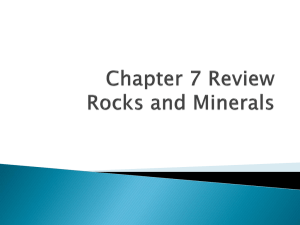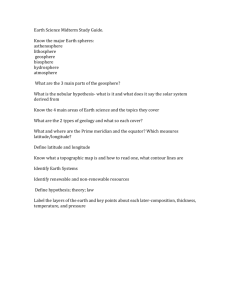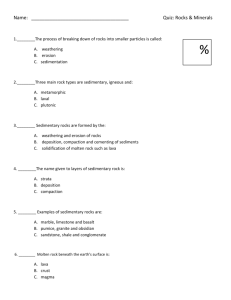Reviewing Minerals
advertisement
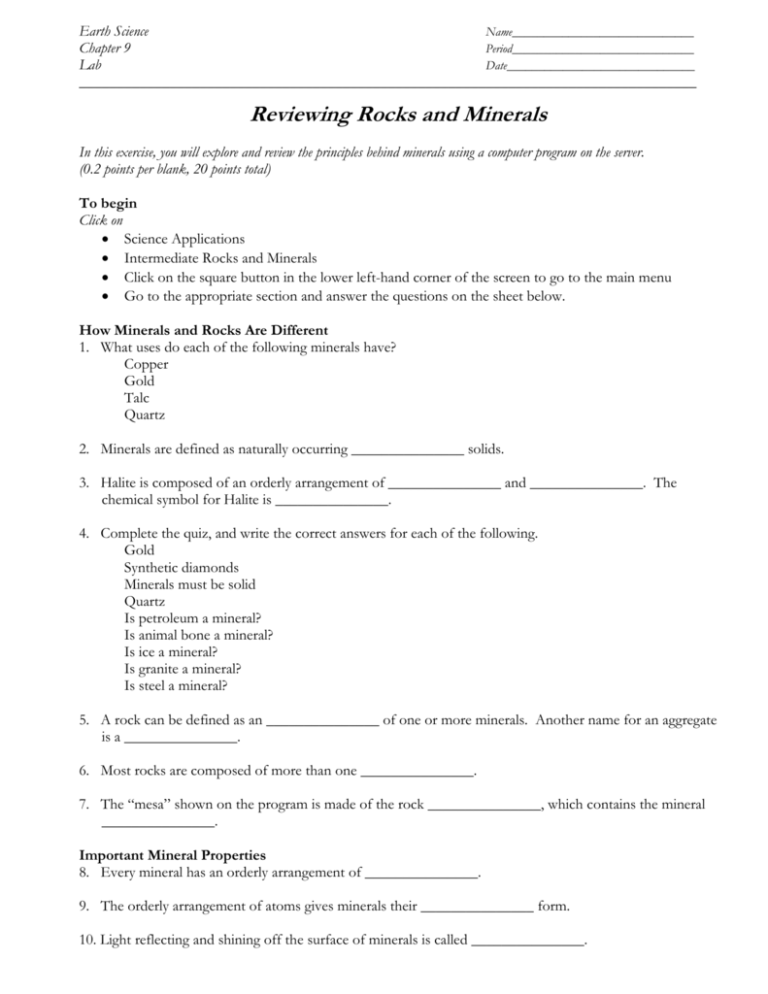
Earth Science Name_____________________________ Chapter 9 Period_____________________________ Lab Date______________________________ __________________________________________________________________________________ Reviewing Rocks and Minerals In this exercise, you will explore and review the principles behind minerals using a computer program on the server. (0.2 points per blank, 20 points total) To begin Click on Science Applications Intermediate Rocks and Minerals Click on the square button in the lower left-hand corner of the screen to go to the main menu Go to the appropriate section and answer the questions on the sheet below. How Minerals and Rocks Are Different 1. What uses do each of the following minerals have? Copper Gold Talc Quartz 2. Minerals are defined as naturally occurring _______________ solids. 3. Halite is composed of an orderly arrangement of _______________ and _______________. The chemical symbol for Halite is _______________. 4. Complete the quiz, and write the correct answers for each of the following. Gold Synthetic diamonds Minerals must be solid Quartz Is petroleum a mineral? Is animal bone a mineral? Is ice a mineral? Is granite a mineral? Is steel a mineral? 5. A rock can be defined as an _______________ of one or more minerals. Another name for an aggregate is a _______________. 6. Most rocks are composed of more than one _______________. 7. The “mesa” shown on the program is made of the rock _______________, which contains the mineral _______________. Important Mineral Properties 8. Every mineral has an orderly arrangement of _______________. 9. The orderly arrangement of atoms gives minerals their _______________ form. 10. Light reflecting and shining off the surface of minerals is called _______________. 11. _______________ has a metallic luster. Gypsum’s luster is _______________. 12. Quartz’s luster is _______________. Talc’s is _______________ and Kaolinite’s is _______________. 13. Complete the quiz on the computer program and write the answers below. Pyrite’s luster is _______________. Quartz’s luster is _______________. This brown rock’s luster is _______________. This speckled minerals luster is _______________. Copper’s luster is _______________. Talc’s luster is _______________. 14. The most obvious characteristic of a mineral is its _______________. 15. Quartz can come in colors such as _______________ , _______________ , _______________ , _______________. 16. Streak is the color of the mineral in _______________ form. 17. Mohs scale of hardness goes from the hardest #10 (_______________), to the softest #1 (_______________). 18. Glass has a hardness of _______________; a Copper penny - _______________; and your fingernail _______________. 19. The purple pyramid shaped mineral has a hardness of _______________. 20. What is the hardness of the yellow mineral? _______________; the clear Quartz? _______________ 21. The tendency of mineral to break along flat surfaces is called _______________. 22. Which mineral has a cleavage plane shaped like this ? _______________ 23. How many planes of cleavage does the “exhibit” have? _______________. 24. How many planes of cleavage does the Calcite exhibit have? _______________. Fracture 25. Fracture is when minerals do not exhibit _______________. 26. Quartz has _______________ fracture. 27. Serpentine asbestos has _______________ fracture. 28. Bornite has _______________ fracture. Specific Gravity 29. Specific gravity compares the weight of a mineral to the weight of an equal volume of ______________. Specific gravity is closely related to the density of a mineral. 30. What are the specific gravity of each of these minerals? Quartz _______________ Feldspar _______________ Halite _______________ 31. What is the weight of the mineral sample on the scale? _______________ How much is the weight of an equal volume of water? _______________ What is the specific gravity of the mineral? _______________ 32. What is the weight of the second sample on the scale? _______________ How much is the weight of an equal volume of water? _______________ What is the specific gravity of the mineral? ________________ 33. What are four special properties mineral may have? _______________ _______________ _______________ _______________ Important Mineral Groups 34. How many different minerals are there? _______________ (only about 50 are abundant) 35. Name four minerals in the “Silicates” group. _______________ _______________ _______________ _______________ 36. What two elements do these minerals contain? _______________ and _______________. Reviewing Minerals Take the mineral quiz and write in your score _______________ (3 points for this question only) Basic Facts About Common Minerals 37. Pick any ten minerals from the 50 listed. List their names and give a brief description of their vital characteristics. A. ___________________________________________________________________________ B. ___________________________________________________________________________ C. ___________________________________________________________________________ D. ___________________________________________________________________________ E. ___________________________________________________________________________ F. ___________________________________________________________________________ G. ___________________________________________________________________________ H. ___________________________________________________________________________ I. ___________________________________________________________________________ J. ___________________________________________________________________________ Reviewing Rocks In this exercise, you will explore and review the principles behind minerals using a computer program on the server. (0.2 points per blank, 20 points total) To begin Click on Science Applications Intermediate Rocks and Minerals Click on the square button in the lower left-hand corner of the screen to go to the main menu Go to the appropriate section and answer the questions on the sheet below. The Rock Cycle 1. List the three main rock types of the rock cycle. 2. How are igneous rocks formed? 3. When igneous rocks are exposed at the surface, they will undergo _______________. 4. List 4 agents of erosion. _______________, _______________, _______________, _______________. 5. After erosion the particles and dissolved substances become _______________ and are deposited. 6. Sediments eventually undergo a hardening process called _______________. This may be done by means of _______________ or _______________ in which sediment grains are held together by a natural _______________. 7. Weathering can either be _______________ or _______________. How igneous rocks form 8. Igneous rocks form when molten rock _______________ and _______________. 9. Molten Rock can move to the surface because it is less _______________ 10. Click to view volcanic ash, cinders and bombs. 11. Extrusive igneous rocks form_______________ the Earth’s surface and intrusive igneous rocks forms _______________ the Earth’s surface. 12. Is a sill a horizontal or vertical igneous rock layer? Circle one 13. The texture of an igneous rock is affected by the _______________ rate of magma. 14. Rapid cooling makes_______________ crystals and slow cooling makes_______________ crystals. 15. Rhyolite has a _______________texture, and granite has a _______________texture. 16. Obsidian on the other hand has a _______________ texture whish indicates its cooling was _______________. 17. How does the density of pumice compare to water? _______________ 18. Light colored igneous rocks are rich in _______________ and _______________. 19. Give an example of a light colored igneous rock. 20. Igneous rocks composed mainly of or quartz and potassium feldspar are said to have _______________. 21. _______________ rocks are commonly found on the continents. 22. Dark-colored igneous rocks mainly composed of pyroxene and calcium-rich feldspar are said to have a _______________. 23. Basaltic rocks are found in the _______________ beneath the oceans on volcanic islands like _______________ and in some volcanic regions on continents. 24. Rocks with a mineral composition between _______________ and_______________ rocks have an _______________ _______________ 25. _______________ _______________ are frequently part of large continental volcanoes. Sedimentary Rocks 26. When rocks are broken into smaller pieces it _______________ the surface area available for _______________ attack. 27. Mechanical weathering breaks rocks into smaller fragments without a change in composition, where as _______________ alters the chemical structure of _______________ by removing and/or adding elements. 28. ______________ is one of the most water-soluble minerals. 29. Many other chemical reaction breaks down rocks by _______________ the chemical structure. 30. Carbonic acid forms when rain dissolves _______________ as it falls through the atmosphere. 31. Carbonic acid slowly reacts with _______________ to produce insoluble clay minerals. 32. These clay minerals are often carried to a body of water where they may eventually become the _______________. 33. _______________, the other main component of granite, is very resistant to _______________ weathering. 34. With the breakdown of feldspar, quartz grains are released, these resistant grains may accumulate as _______________, _______________ or other sandy deposits. 35. List three types of sedimentary rocks; _______________, ________________, & _______________. 36. Under what conditions may sedimentary rock turn into metamorphic rock? ________________ 37. Can sedimentary rock turn into igneous rock? _____. If so, under what conditions? _______________ How Sedimentary Rocks Form 38. In frost wedging, it is broken into _______________ pieces. 39. At the base of a cliff, falling rock can produce a _______________ slope. 40. Breaking rock into _______________ pieces _______________ the surface area available for chemical attack. 41. Mechanical weathering breaks into smaller fragments without a change in composition, _______________ _______________ alters the chemical structure of _______________ by removing and adding elements. 42. A simple type of chemical weathering occurs when a mineral ________________ in water. 43. Halite is one of the most _________________________. 44. Halite’s composed of _______________ charged sodium ions and _______________ charged chloride ions. 45. Halite dissolves in _______________ because _______________ end of the water molecule. 46. Calcite ________________ in acid. 47. Rainwater combining with carbon dioxide produces _______________ acid. 48. Which part of the rock granite disintegrates from carbonic acid? ________________ What weathered product does it turn into? _______________ 49. Eventually clay turns into the sedimentary rock _______________. 50. Lithification (hardening) of sediments can be done by _______________ or by _______________. 51. Three sedimentary rocks are ________________, _______________, and _______________. Metamorphic Rocks 52. The word metamorphic means _______________ _______________. 53. Can metamorphic rock form from an igneous rock? _____ …from a sedimentary rock? _____ …from other metamorphic rocks? _____ 54. Metamorphosis in rocks can be caused by _______________, _______________ and ____________________. 55. Heated sulfur and iron turn to the mineral _______________.
